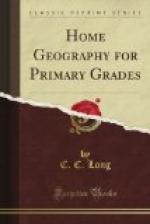Some minerals are called metals. Iron, gold, silver, copper, tin, and mercury are metals.
Iron is the most useful of all metals. Did you ever think what we should do without this hard, strong metal? The following lines tell some of the uses of iron:
[Illustration: IRON MINE.]
Iron vessels cross the ocean.
Iron engines give them motion;
Iron pipe our gas delivers,
Iron bridges span our rivers,
Iron horses draw our loads,
Iron rails compose our roads;
Iron houses, iron walls,
Iron cannon, iron balls,
Iron lightning rods on spires,
Iron telegraphic wires,
Iron hammers, nails, and screws,
Iron everything we use.
Steel is iron made very hard. Knives, axes, hatchets, and other tools are made of steel. Many little things are made of steel. Mention some of them.
Which is the most valuable of all metals? Is all the gold made into money? Is money made of pure gold? Why? Name articles of ornament made of gold. Articles of use. Are gold watches, chains, and rings usually made of pure gold? Why? What do you call the man who makes these articles?
[Illustration: CASTING IRON FROM THE ORE.]
Silver is the whitest and most lustrous of all the metals. What does “lustrous” mean? Is iron lustrous? Are silver articles usually made of pure silver? Why?
Silver and gold are found among the mountains in the west. Sometimes they are dug out of the ground. Sometimes they are found in rocks, and the rocks must be broken up before they can be taken out.
[Illustration: “SOMETIMES MEN WASH DOWN THE HILLS.”]
Sometimes men wash down the hills with streams of water in order to get at the silver or gold among the rocks.
Gold and silver are called the precious metals because they do not rust, and on account of their scarcity.
Tin is white and bright, but too soft to make articles which shall be light and strong. Therefore, thin plates of iron are dipped into melted tin. The tin adheres to the iron and makes it bright like tin itself.
A thin sheet of iron, covered with tin, is called tin-plate. It is of this that our tin cups, pans, and kitchen utensils are made. A tin cup is really made of iron.
Lead is a very heavy metal. It is so soft that it can be cut with a knife. It is used in making shot, and water pipes.
Do you know how shot is made? Did you ever see a shot-tower? Small shot is made by dropping melted lead through a sieve in rapid motion, from the top of a high tower. The drops fall into a vessel of water below. They are next polished and made black, and then are ready for sale.
You think, I suppose, that the lead pencil with which you write is made of lead. It is not made of lead, but of graphite, which is a kind of coal.
Copper is softer than iron, but harder than lead. It will not rust. Cooking vessels are often made of copper.




